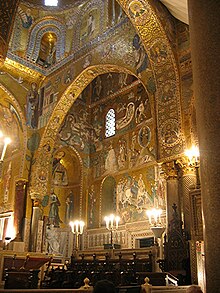
Back التأثير الإسلامي على الفن الغربي Arabic Influències islàmiques en l'art cristià Catalan Influencias islámicas en el arte occidental Spanish تاثیرهای اسلامی بر هنر غربی Persian Influences de l'Islam sur l'art occidental French Influenze islamiche nell'arte occidentale Italian Pengaruh Islam terhadap seni lukis Barat Malay Islamski vpliv na zahodno umetnost Slovenian Ісламський вплив на західне мистецтво Ukrainian


Islamic influences on Western art refers to the stylistic and formal influence of Islamic art, defined as the artistic production of the territories ruled by Muslims from the 7th century onward, on European Christian art. Western European Christians interacted with Muslims in Europe, Africa, and the Middle East and formed a relationship based on shared ideas and artistic methods.[1] Islamic art includes a wide variety of media including calligraphy, illustrated manuscripts, textiles, ceramics, metalwork, and glass, and because the Islamic world encompassed people of diverse religious backgrounds, artists and craftsmen were not always Muslim, and came from a wide variety of different backgrounds. Glass production, for example, remained a Jewish speciality throughout the period. Christian art in Islamic lands, such as that produced in Coptic Egypt or by Armenian communities in Iran, continued to develop under Islamic rulers.
Islamic decorative arts were highly valued imports to Europe throughout the Middle Ages. In the early period, textiles were especially important, due to the labor-intensive nature of their production. These textiles originating in the Islamic world were frequently used for church vestments, shrouds, hangings and clothing for the elite. Islamic pottery of everyday quality was still preferred to European wares.[2]
In the early centuries of Islam, the most important points of contact between the Latin West and the Islamic world from an artistic point of view were Southern Italy, Sicily, and the Iberian peninsula, which both held significant Muslim populations. Later the Italian maritime republics were important in trading artworks. In the Crusades, Islamic art seems to have had relatively little influence even on the Crusader art of the Crusader kingdoms, though it may have stimulated the desire for Islamic imports among Crusaders returning to Europe. Islamic architecture, however, appeared to influence the designs of Templar churches within the Middle East and other cathedrals within Europe upon the return of Crusaders in the 12th and 13th century.[3]
Numerous techniques from Islamic art formed the basis of art in the Norman-Arab-Byzantine culture of Norman Sicily, much of which used Muslim artists and craftsmen working in the style of their own tradition. Techniques included inlays in mosaics or metals, often used for architectural decoration, porphyry or ivory carving to create sculptures or containers, and bronze foundries.[4] In Iberia the Mozarabic art and architecture of the Christian population living under Muslim rule remained very Christian in most ways, but showed Islamic influences in other respects; much what was described as this is now called Repoblación art and architecture. During the late centuries of the Reconquista Christian craftsmen started using Islamic artistic elements in their buildings, as a result the Mudéjar style was developed.
- ^ Heschel, Susannah; Ryad, Umar (2019). The Muslim Reception of European Orientalism. New York: Routledge. ISBN 978-1-138-23203-7.
- ^ Mack 2001, pp. 3–8, and throughout
- ^ Darke, Diana (2020). Stealing from the Saracens how Islamic architecture shaped Europe. ISBN 978-1-78738-305-0. OCLC 1197079954.
- ^ Aubé 2006, pp. 164–165